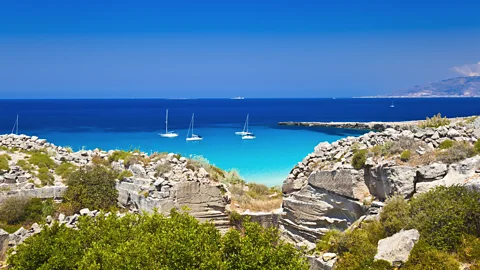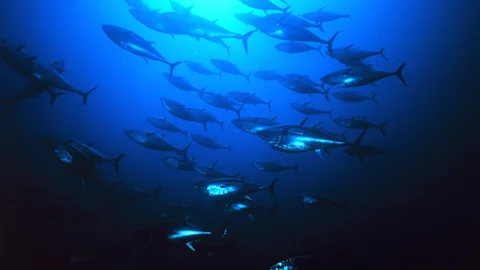On an Italian island, fishermen guard a musical secret. Could it change how we fish?
 Getty Images
Getty ImagesSicily's mysterious ocean songs contain secret messages about ancient fishing practices – with ramifications for today’s ecology.
Until a few years ago, a mysterious ritual happened on the Egadi (Aegadian) islands off the east coast of Sicily every spring. A tight-knit community of fishermen, following a traditional leader known as a rais, would take to the sea in their boats and begin a chorus of ancient, beautiful songs. The rais led the chorus as well as overseeing the complex fishing routine – known as the mattanza, which literally means "slaughter".
The mattanza traditionally only occurred for a few days a year. It involved fishing tuna for the community and for sale, while allowing the remaining tuna to reproduce and restore their population over the following months before the ritual began again.
The accompanying songs, which were handed down the generations, tell the story of a unique relationship between the islanders and the ocean, on which they depend for their sustenance. But the fate of the mattanza also casts an important spotlight on how different practices can affect fishing stocks.
The spring of 2019 marked the last mattanza at Favignana, the biggest of the Egadi islands. The ritual ended because tuna stocks had become severely depleted – due to other, more intense fishing methods, and global demand for tuna. Traditional, and potentially more sustainable, fishing methods were barely profitable.
"The mattanza has been my life since I was very small. I used to help on land, sorting the fibres of coconuts, which were used to make the nets," says Salvatore Spataro. He is the last rais of the mattanza, with a face as deeply creased as the sea-carved rocks around the island. "Now we old people analyse the wind and how it would affect the fishing, but I miss seeing the boats on the water. I don't want to believe that it is over," he adds.
Tuna fishing is tightly intertwined with the cultural history of the entire archipelago, which consists of bigger islands such as Favignana, Levanzo and Marettimo, and a host of smaller islands. Some of them are little more than boulders dropped in the sea. The songs accompanying the mattanza were thought to protect the fishermen on these islands and bring good fortune in their work, but they also passed on important knowledge about when and how to fish in a way that allowed the practice to continue for generations.
Prehistoric diet
Tuna has long been a key source of sustenance for people living on the Egadi islands. In 1949, a painter called Francesca Minellona crawled through an open fissure in the rocky cliffs of north Levanzo. Through the tunnel, she discovered a cave – now known as the Grotta del Genovese – that was filled with paintings and engravings of prehistoric life. Archaeologists estimate that they may date to 11,000 years ago, and among the creatures that are depicted, we can see large tuna fish – a sign that they were already part of inhabitants' diet.
Some experts suspect that the mattanza may reflect prehistoric fishing practices. "It is a bloody act of tragic beauty essentially unchanged since the Stone Age," writes Theresa Maggio in her book Mattanza: Love and Death in the Sea of Sicily. Others, such as French historian Fernand Braudel, suggest that the method came from the ancient Phoenicians, who lived in a region of the Eastern Mediterranean around modern-day Lebanon from around 2500 to 64BC. In this way, the mattanza could be emblematic of the Mediterranean's cultural melting pot.
Whenever it began, the ritual hinges on the seasonal behaviour of the fish, which swim from the Atlantic into the Mediterranean for their spawning season. "The time that they passed by was very predictable," says Alessandro Buzzi, the global tuna lead at the World Wildlife Fund (WWF) who specialises in tuna fishing. This allowed the fishermen to prepare the tonnara – the intricate structure of nets that would capture their haul.
 Alessia Franco
Alessia FrancoMaster of ceremonies
The rais played a crucial role in overseeing the fishermen, and held a respected position in the local community. In the past, he would wear garlands of flowers and would even be carried to his boat by the other fishermen so that his feet did not touch the ground. "Once upon a time, the rais was like the mayor," Spataro explains. Everything revolved around this master: the management of the crew, the positioning of the nets in the sea, the wait for the fish to bite and the hauling of the nets. The rais also decided when the fishermen sang and when they kept quiet.
Spataro's own path to becoming the last rais began at just 14 years of age, when he first went out to sea to fish for tuna. The elder fishermen soon recognised his intuitive understanding of the ocean and helped him learn the necessary skills. By 24, he was the head of his ship. He speaks with gravity, aware of his position the last rais, as he describes the rituals of the mattanza and the traditional sequence of songs, called cialome, that gave rhythm to the fishermen's work. The word, according to the ethnomusicologist Sergio Bonanzinga at the University of Palermo, derives from a ancient Greek word meaning to command or exhort, through the ancient Sicilian word chiloma, "cry of the sailors".
It is in this last stage of the fishing that the work and the songs start to synchronise, as all the fishermen adopt the same rhythm to pull the nets from the sea. (You can listen to a recording of the first song in the sequence, called Aiamola, in this clip.)
"The song begins with one man," explains Spataro, "from which follows the choir of the other fishermen, while they pull the nets." The rais doesn't sing, but directs the others with a whistle and with his hands, "like the conductor of an orchestra".
In the last stage of the fishing ritual, the work and the songs start to synchronise, as all the fishermen adopt the same rhythm to pull the nets from the sea. The final part of the mattanza was the most demanding: the nets had to be raised, while the tuna was harpooned and deposited in large boats. The rhythms of the singing became more rapid and helped coordinate the movements. (You can listen to a clip of one of these faster songs, called Gnianzò, here.)
There is also a spiritual element to the tradition. Spataro explains that the entrance to the labyrinth of nets was marked by a wooden cross engraved with the names of the saints invoked in the cialome, including Saint Peter, Saint Anthony, and the Madonna del Calvario. The mattanza finished with three cries of Jesus' name. Anthropologist Elsa Guggino, describing the ritual when it was still an active part of island life, wrote that the songs "recall the moment of creation; the hand of God that moulds everything they describe: the sun and the moon, men, the tuna and the fishing nets".
The fishermen also sing as they assemble and dismount the tonnara nets. The songs for this stage of the work, such as Lina Lina and Zza monaca ncammisa, are more playful than the others and verge on the profane.
 Getty Images
Getty ImagesThe death of the mattanza
The mattanza is a bloody ceremony and, like any form of fishing, brutal and deadly for the individual fish. However, from an ecological point of view, it was relatively sustainable, says the WWF's Buzzi: "It was managed, I would say, in harmony with nature".
Over the 20th Century however, the global trade of tuna boomed, leading to increasingly intensive means of fishing the stocks. The industrial-scale operations would often use speed boats and spotter planes to identify the shoals for catching. By the 2000s, the natural populations of bluefin tuna had started to vanish across the Mediterranean. One of the WWF's studies, for example, found tuna stocks falling by a whopping 85% from 1996 to 2006 – raising alarms of an impending extinction.
International regulations, including fishing quotas and minimum fish sizes to avoid the killing of juveniles, have helped tuna stocks recover, Buzzi says. According to recent studies, the population of bluefin tuna has now returned to around 50% of that in 1950. In 2021, the species changed category in the International Union for Conservation of Nature's Red List, from "endangered" to "least concern".
"I would say that bluefin tuna fishing can be named as one of the best success stories for the successful managing of a stock that was really on the verge of collapse," says Buzzi.
While mattanza tradition could in theory be revived under those sustainability criteria, in practice, there is now another obstacle for the fishermen, Buzzi says: economic pressure. In a globalised fishing industry, artisan fishermen can't match the prices of the larger operations, he says. "It's a very costly operation and requires a lot of manpower," he says of the traditional method.
He wonders, however, whether traditional fishing could be brought back for high-end restaurants that would tell the history of the product and its cultural importance in the region. People may be willing to pay a higher price for the experience, Buzzi suggests, while eating smaller quantities. "It could be sustainable, and enrich the community," he says.
Spataro would certainly welcome any attempts to bring the songs of the mattanza back to the seas around Favignana. "Today there is a north wind – a wind that would be good for tuna," he says. "It is sad to think that people are no longer learning this ancient art."
For now, the tradition survives only in the form of the songs – which Spataro and others on the island still sing on occasion, celebrating the tradition that shaped their islands and environment.
* Alessia Franco is an author and a journalist focusing on history, culture, society, storytelling and its effects on people. She is La Raccontatrice on Facebook and @la_raccontatrice on Instagram
** David Robson is an award-winning science writer and author. His latest book is The Laws of Connection: 13 Social Strategies That Will Transform Your Life. He is @d_a_robson on Twitter and @davidarobson on Instagram and Threads.
--
If you liked this story, sign up for The Essential List newsletter – a handpicked selection of features, videos and can't-miss news, delivered to your inbox twice a week.
